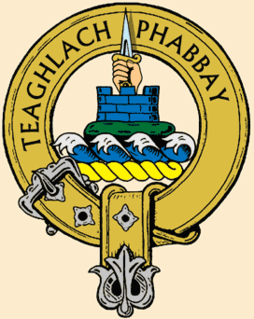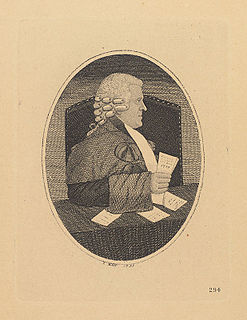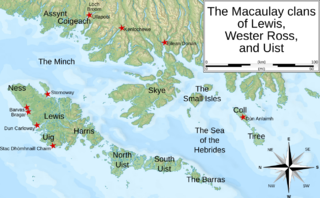Related Research Articles

Clan MacLeod is a Highland Scottish clan associated with the Isle of Skye. There are two main branches of the clan: the MacLeods of Harris and Dunvegan, whose chief is MacLeod of MacLeod, are known in Gaelic as Sìol Tormoid ; the Clan MacLeod of Lewis and Raasay, whose chief is MacLeod of The Lewes, are known in Gaelic as Sìol Torcaill. Both branches claim descent from Leòd, who lived in the 13th century.
Leod was the eponymous ancestor and founder of Clan MacLeod and Clan MacLeod of Lewis. Almost nothing is known about him and he does not appear in any contemporary records. Tradition dating to the late 18th century made him a son of Olaf the Black who was King of Man. Heraldic evidence, dating to the late 17th century, is considered to be the earliest evidence of descent from Olaf the Black. However, in recent years, this traditional lineage has been challenged and is no longer considered fact by one historian.

Clan Mackenzie is a Scottish clan, traditionally associated with Kintail and lands in Ross-shire in the Scottish Highlands. Traditional genealogies trace the ancestors of the Mackenzie chiefs to the 12th century. However, the earliest Mackenzie chief recorded by contemporary evidence is Alexander Mackenzie of Kintail who died some time after 1471. Traditionally, during the Wars of Scottish Independence, the Mackenzies supported Robert the Bruce, but feuded with the Earls of Ross in the latter part of the 14th century. During the 15th and 16th-centuries the Mackenzies feuded with the neighboring clans of Munro and MacDonald. In the 17th century the Mackenzie chief was made Earl of Seaforth in the peerage of Scotland. During the Scottish Civil War of the 17th century the Mackenzies largely supported the Royalists. During the Jacobite rising of 1715 the chief and clan of Mackenzie supported the Jacobite cause. However, during the Jacobite rising of 1745 the clan was divided with the chief, Kenneth Mackenzie, Lord Fortrose, supporting the British-Hanoverian Government and his relative, George Mackenzie, 3rd Earl of Cromartie, supporting the Jacobites.

Clan Mackay is an ancient and once-powerful Highland Scottish clan from the far North of the Scottish Highlands, but with roots in the old Kingdom of Moray. They supported Robert the Bruce during the Wars of Scottish Independence in the 14th century. In the centuries that followed they were anti-Jacobite. The territory of the Clan Mackay consisted of the parishes of Farr, Tongue, Durness and Eddrachillis, and was known as Strathnaver, in the north-west of the county of Sutherland. However, it was not until 1829 that Strathnaver was considered part of Sutherland when the chief sold his lands to the Earls of Sutherland and the Highland Clearances then had dire consequences for the clan. In the 17th century the Mackay chief's territory had extended to the east to include the parish of Reay in the west of the neighbouring county of Caithness. The chief of the clan is Lord Reay and the lands of Strathnaver later became known as the Reay Country.

Clan Morrison is a Scottish clan. The Highland Clan Morrison is traditionally associated with the Isle of Lewis and Harris (Leòdhas) around Ness (Nis), Dun Pabbay, and Barvas (Barabhas), lands in Sutherland around Durness, and in North Uist. There are numerous Scottish clans, both Highland and Lowland, which use the surname Morison or Morrison. In 1965, the Lord Lyon King of Arms decided to recognise one man as chief of all Morrisons, whether their clans were related or not.

The Fairy Flag is an heirloom of the chiefs of Clan MacLeod. It is held in Dunvegan Castle along with other notable heirlooms, such as the Dunvegan Cup and Sir Rory Mor's Horn. The Fairy Flag is known for the numerous traditions of celtic fairies, and magical properties associated with it. The flag is made of silk, is yellow or brown in colour, and is a square of side about 18 inches. It has been examined numerous times in the last two centuries, and its condition has somewhat deteriorated. It is ripped and tattered, and is considered to be extremely fragile. The flag is covered in small red "elf dots". In the early part of the 19th century, the flag was also marked with small crosses, but these have since disappeared. The silk of the flag has been stated to have originated in the Far East, and was therefore extremely precious, which led some to believe that the flag may have been an important relic of some sort. Others have attempted to associate the flag with the Crusades or even a raven banner, which was said to have been used by various Viking leaders in the British Isles.

The Brahan Seer, known in his native Scottish Gaelic as Coinneach Odhar, and Kenneth Mackenzie, was, according to legend, a predictor of the future who lived in the 17th century.

Clan MacLeod of The Lewes, commonly known as Clan MacLeod of Lewis, is a Highland Scottish clan, which at its height held extensive lands in the Western Isles and west coast of Scotland. From the 14th century up until the beginning of the 17th century there were two branches of Macleods: the MacLeods of Dunvegan and Harris ; and the Macleods of the Isle of Lewis. In Gaelic the Macleods of Lewis were known as Sìol Thorcaill, and the MacLeods of Dunvegan and Harris were known as Sìol Thormoid.

Sir William Macleod Bannatyne, Lord Bannatyne FRSE was a distinguished Scottish advocate, judge, antiquarian and historian.

The Macaulay family of Uig in Lewis, known in Scottish Gaelic as Clann mhic Amhlaigh, were a small family located around Uig on the Isle of Lewis in the Outer Hebrides of Scotland. There is no connection between the Macaulays of Lewis and Clan MacAulay which was centred in the Loch Lomond area, bordering the Scottish Highlands and Scottish Lowlands. The Macaulays of Lewis are generally said to be of Norse origin because of the etymology of their surname and also because of the islands' Viking Age past. However, a recent analysis of the Y-DNA of men with Scottish surnames has shown that a large number of Hebridean Macaulays are of Irish origin. In the 17th century, however, tradition gave the Macaulays an Irish origin. By the end of the 16th century the dominant clan on Lewis was Clan Macleod of The Lewes. Other notable Lewis clans were the somewhat smaller Morrisons of Ness and the even less numerous Macaulays of Uig. The Macaulays were centred in the area surrounding Uig on the western coast of Lewis, and had a deadly, long-standing feud with the Morrisons, whose lands were located on the northern coast around Ness. Today the Lewis surname Macaulay is considered to be a sept name of the Macleods of Lewis. There are two other nearby clans of Macaulays who may, or may not, be connected to the Lewis clan—the Wester Ross Macaulays, and the Uist MacAulays.

The Battle of Leckmelm was a Scottish clan battle that took place in 1586, in the Scottish Highlands. It was fought between the Clan Gunn against the Clan Sutherland, Mackays of Aberach and the MacLeods of Assynt.

Sir Rory Mor's Horn is a drinking horn, one of several heirlooms of the MacLeods of Dunvegan, chiefs of Clan MacLeod. Clan custom is that each successive chief is to drink a full measure of the horn in wine to prove his manhood. The artwork on the horn has been dated to the 16th century, and by some as far back as the 10th century. The MacLeod chiefs have several other notable heirlooms kept at Dunvegan Castle, such as the Fairy Flag and the Dunvegan Cup.
Tormod MacLeod, sometimes referred to as Norman MacLeod, was a west Highland lord, and son of Leod, the traditional founder and eponymous ancestor of Clan MacLeod. Little is known about Tormod; like his father Leod, he does not appear in any contemporary records. His name is remembered today in the Scottish Gaelic name Sìol Thormoid, used by a branch of his descendants, the MacLeods of Dunvegan, who are chiefs of Clan MacLeod.

Iain Borb MacLeod (1392–1442) is considered to be the sixth chief of Clan MacLeod. He is the first MacLeod chief to which heraldry can be assigned. Clan tradition states that he was a minor at the time of his father's death and for six years an incompetent guardian led the clan to its lowest point in clan history. After reaching the age of maturity, Iain Borb managed to acquire some of the clan's lost lands and led his clan and his kinsmen in the Battle of Harlaw, in 1411. Iain Borb was wounded in the head during the conflict; the wound never completely healed and confined him to his home on Pabbay for much of his life. Tradition states that he died when this wound re-opened during a fencing/wrestling match. There is some disagreement as to which of his sons was the eldest; however, his son William Dubh was the one who finally succeeded to the chiefship, following his death in 1442.
Iain Ciar MacLeod is considered to be 4th Chief of Clan MacLeod. He was the eldest son of, and is thought to have succeeded his father, Malcolm, in the years spanning 1360–1370. Clan tradition states that he was the most tyrannical of all MacLeod chiefs. His wife supposedly was as cruel as he was; she is said to have had two of her daughters buried alive in the dungeon of Dunvegan Castle when they attempted to leave the clan. Iain Ciar was killed in an ambush in about 1392. He was succeeded by his second and only surviving son, William Cleireach.
Malcolm MacLeod (1296–1370) is considered to be the 3rd Chief of Clan MacLeod. He was the son of Tormod. Malcolm and his kinsman Torquil are the first MacLeod chiefs to appear in contemporary records. Clan tradition states he was the greatest hero of the clan and links him to the origin of the clan relic known as Sir Rory Mor's Horn. He is said to have become extremely overweight in his old age and was known as 'Good Fat Malcolm' or 'Malcolm the thick-legged'. According to tradition he was buried at Iona. Malcolm's son, Iain Ciar MacLeod, succeeded him as chief of the clan.
William Cleireach MacLeod is considered to be 5th Chief of Clan MacLeod. He was a younger son of chief Iain Ciar and was originally intended to enter the church, as his nickname shows; however, on the death of his elder brother, William Cleireach became the heir to the chiefship. As chief of the clan, he led his followers in attacks against the Frasers and defended his lands against the MacDonalds. He did not live a long life and was said to have been buried on the isle of Iona with his predecessors.
William Dubh MacLeod is considered to be the 7th Chief of Clan MacLeod. He is thought to have been a younger son, yet because of the death of his elder brother, William Dubh succeeded his father, Iain Borb, in the year 1442. William Dubh was an old man when he was killed, leading his clan, at the Battle of Bloody Bay in 1480. He was the last MacLeod chief to be buried on the island of Iona. He was succeeded by his son, Alasdair Crotach.

Alasdair Crotach MacLeod is considered to be the 8th Chief of Clan MacLeod. He was the son of the 7th Chief of Clan MacLeod, William Dubh, and succeeded his father in 1480, following William Dubh's death at the Battle of Bloody Bay. He was the first MacLeod chief not to be buried on the island of Iona.
Gilhemoire(born approximately 1207-8 AD) is the progenitor of the Scottish Clan Morrison, and half-brother to Leod, the progenitor of the Scottish Clan Macleod, according to Clan traditions.
References
- MacLeod, RC (1927). The MacLeods of Dunvegan. The Clan MacLeod Society – via Internet Archive.
- Morrison, A (1986). "The Origin of Leod". Associated Clan MacLeod Societies Genealogical Resource Centre. Archived from the original on 3 August 2016. Retrieved 17 January 2010.
- Sutherland, A (2005). The Brahan Seer: The Making of a Legend, c1570–2001 (PhD thesis). University of Aberdeen.
- Sutherland, A (2009). The Brahan Seer: The Making of a Legend. Oxford: Peter Lang. ISBN 978-3-03911-868-7.
- Macleod, E Vincent (2004). "Bannatyne, Sir William Macleod, Lord Bannatyne (1744–1833)" . Oxford Dictionary of National Biography (online ed.). Oxford University Press. doi:10.1093/ref:odnb/1311 . Retrieved 7 September 2016.(Subscription or UK public library membership required.)